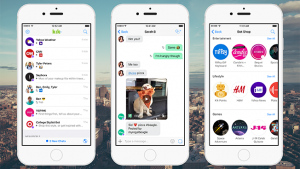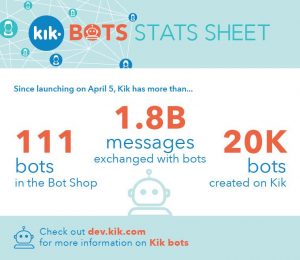 After its first few months offering dozens of chatbots, Kik says users have caught on and exchanged nearly 2 billion messages with brands, entertainment companies and publishers on the platform.
After its first few months offering dozens of chatbots, Kik says users have caught on and exchanged nearly 2 billion messages with brands, entertainment companies and publishers on the platform.
According to statistics released on August 4, by the Canadian messaging app, users have exchanged 1.8 billion messages with the more than 20,000 bots created by developers since Kik first opened the floodgates in April.
The momentum could be good news for brands on the platform hoping to build engagement with fans. Already, around 60 or 70 brands have gone through Kik’s vetting process to enter the “Bot Shop”—as its bot discovery area is known—with another 40 or so going through some sort of advertising trial on Kik.
“We’re basically looking at ways to create new ways to connect with especially Gen Z, but especially Gen Z and millennial audiences more on their turf,” Kik Services president Josh Jacobs told Adweek. “Rather than a static presence, this is more of an interactive platform rather than simply broadcasting at them.”
 Kik certainly has plenty of both generations—60 percent of bot users are between 13 and 19 years old. There are also more females than males using bots, and 81 percent of all users are from the U.S. (Canada and the U.K. have the second- and third-most users.)
Kik certainly has plenty of both generations—60 percent of bot users are between 13 and 19 years old. There are also more females than males using bots, and 81 percent of all users are from the U.S. (Canada and the U.K. have the second- and third-most users.)
While much of the growth has been directly through the Bot Shop, Kik has been adding ways to spread bots via word of mouth. Last month, it introduced a way for users to invite friends to try out bots, which helped one zombie invasion game bot increase its subscribers by 20 percent.
Instead of focusing on traditional online metrics such as web traffic and bounce rates, Kik has been working to create a framework focused on attention, looking at the number of messages or the time of interaction. For example, Jacobs said, one major film marketer saw nearly 15 minutes of time spent with its bot, while some retailers have sent and received close to 100 messages.
So what kind of content is most popular?
“I actually think the No. 1 content type is conversation,” Jacobs said. “The fun and the power of the bot is that the brand or business has a personality and can have a conversation with you and can conduct activities or games along those lives, and it becomes a a way of interactively experiencing a brand rather than another way of looking at an RSS feed or something like that.”
Source: Adweek

You must be logged in to post a comment Login